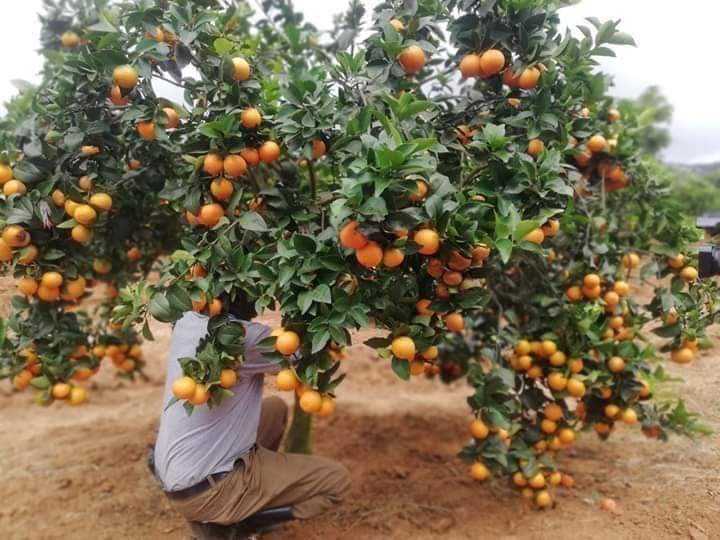POST-HARVEST MANAGEMENT
Post-harvest management is crucial to ensure the quality, longevity, and market value of
harvested jabuticaba fruits. Here's a guide on how to manage jabuticaba post-harvest:
1. Harvesting Time:
Harvest jabuticaba fruits when they are fully ripe. They should be dark purple to black in
color.
2. Gentle Handling:
Handle the fruits gently to avoid bruising or damaging the delicate skin.
3. Sorting and Grading:
Sort the fruits based on size, color, and quality. This helps in creating uniform batches
for better market presentation.
4. Cleaning:
Wash the fruits using clean water to remove any dirt or residues. Ensure they are
completely dry before packaging.
5. Packaging:
Pack the fruits in perforated plastic bags or containers to allow for proper ventilation.
Packaging helps protect the fruits during transportation and storage.
6. Storage Conditions:
Store jabuticaba fruits in a cool and well-ventilated environment. The ideal temperature
for storage is around 50°F (10°C).
Maintain high humidity levels to prevent the fruits from drying out.
7. Shelf Life Enhancement:
Extend the shelf life by storing the fruits in a controlled atmosphere or using refrigeration
methods.
8. Minimal Processing:
Consider minimal processing techniques such as washing, drying, or packaging to
increase the market value and shelf life.
9. Quality Control:
Regularly inspect stored fruits for any signs of decay, mold, or pest infestation. Remove
damaged fruits promptly to prevent spreading.
10. Transportation:
Use appropriate transportation methods to minimize jostling and bruising during transit.
Ensure proper ventilation to avoid moisture build-up.
11. Market Timing:
Time the market entry strategically to maximize profits. Be aware of local market
demand and competition.
12. Value-Added Products:
Explore the possibility of creating value-added products such as jams, jellies, or juices.
This can help utilize surplus fruits and diversify income streams.
13. Marketing Strategies:
Develop effective marketing strategies to promote your jabuticaba fruits. Utilize local
markets, grocery stores, or online platforms to reach a wider audience.
14. Record Keeping:
Maintain detailed records of post-harvest activities, including harvesting dates, storage
conditions, and sales data. This information can guide future decisions and
improvements.
15. Community Engagement:
Engage with local communities or farmer groups to share knowledge, resources, and
market information. Collective efforts can enhance post-harvest management practices.
16. Quality Check:
Keep a keen eye on the quality of your jabuticaba fruits. Regularly inspect them for any
spots, irregularities, or signs of spoilage.
17. Ethylene Caution:
Jabuticaba doesn't like ethylene, a natural ripening gas. Store them away from fruits like
apples or bananas to prevent early ripening.
18. Smart Ripening:
If needed, use controlled ripening methods to ensure a steady and synchronized supply
to the market.
19. Cold Chain Care:
For long-distance transport, maintain a cold chain. This helps keep a consistent
temperature and preserves the freshness of the fruit.
20. Hygiene First:
Keep it clean! Practice good hygiene during handling and processing to avoid
contamination and ensure the safety of your fruit.
21. Attractive Packaging:
Make your jabuticaba stand out with eye-catching packaging and labeling. Share details
about its origin, quality, and potential health benefits.
22. Educate Consumers:
Spread the word about jabuticaba! Teach consumers about its unique qualities,
nutritional benefits, and different ways to enjoy it.
23. Diverse Products:
Get creative! Explore making dried jabuticaba snacks, fruit preserves, or even skincare
products. Diversifying adds extra value to your harvest.
24. Local Business Collaboration:
Team up with local businesses like bakeries or juice bars to feature jabuticaba in their
products. This not only supports local businesses but also boosts your market
presence.
25. Modern Storage Tech:
Upgrade your storage game. Invest in modern technologies like controlled atmosphere
storage or modified atmosphere packaging for optimal fruit preservation.
26. Stay Market Savvy:
Keep your finger on the market's pulse. Regularly research consumer preferences,
market trends, and potential competitors to adapt your strategies accordingly.
27. Eco-Friendly Practices:
Go green! Use environmentally friendly packaging options and sustainable post-harvest
practices to appeal to eco-conscious consumers.
28. Feedback Collection:
Listen to your customers! Gather feedback from consumers, retailers, and distributors to
improve your post-harvest processes and address any concerns.
29. Seasonal Strategy:
Plan ahead. Align your harvest and marketing strategies with the seasonal availability of
jabuticaba to optimize production and sales.
30. Keep Learning:
Stay curious! Stay updated on the latest in post-harvest technologies, storage
techniques, and market trends. Continuous learning keeps you ahead in the game.
By incorporating these additional points into your post-harvest plan, you're not just
growing jabuticaba; you're thriving in the market. Adjust these practices to fit your
specific situation for the best results. Happy farming!





